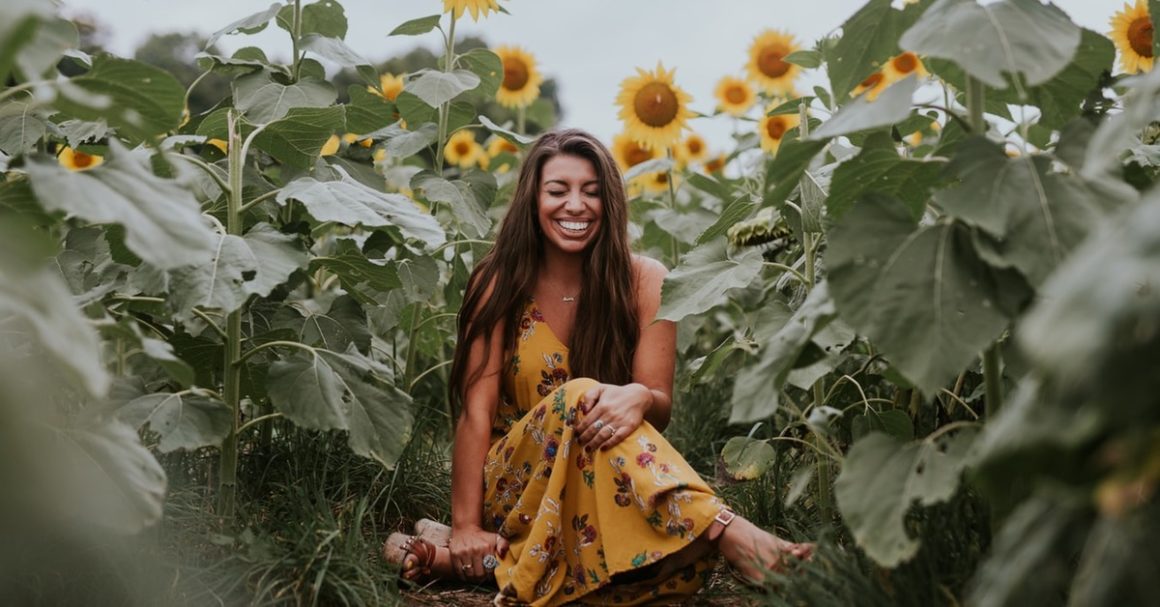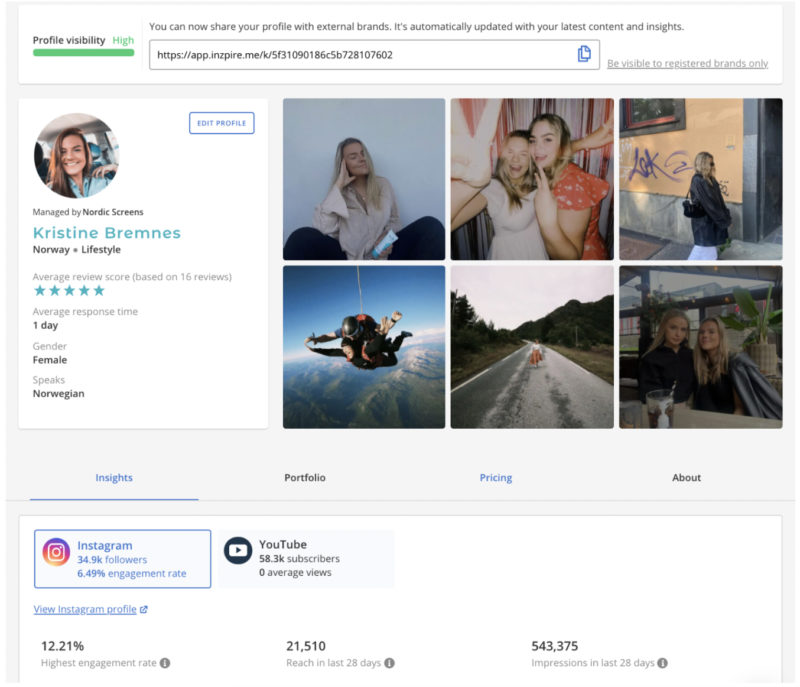Brands and companies are always on the hunt for new influencer talent. If you want to stand out from the crowd and score the best brand partnerships, you’ll need to create a media kit! It’s essential to making a professional and organized first impression.
Whether you’re a blogger, TikToker, or Instagrammer, influencer media kits are the perfect way to introduce yourself and your services to brands. In this article, you’ll find out everything you need to know about influencer media kits, from how to create one, to how to use one to get great brand partnerships.
Table of Contents
What’s an influencer media kit?
An influencer media kit is like a portfolio, resume, and a digital business card all rolled into one. It’s a compact, easy-to-read document that you can send to brands as a way to introduce yourself.
In one neat package, it tells the brand everything they need to know about you and your influencer status. From details about your social media channels to information about your goals and audience demographic, it should include everything about who you are, and why you’re the right influencer to collaborate with their brand.
Why should you have an influencer media kit?
Influencer media kits are fast becoming an industry standard. Many brands expect to see well-made media kits, just like a traditional job would expect to see a great resume. Having a great influencer media kit can help you in a number of ways. You’ll:
- Be prepared if you’re approached by brands
- Seem more professional and trustworthy
- Create a simple way for brands to learn more about your work and key metrics
- Help you to score better partnership deals and negotiate better contract terms
In a nutshell, having a great media kit makes interacting with brands a lot easier. With so many great influencer media kit templates available online, they won’t take more than a couple of hours to make.
To create a free media kit using inzpire.me that tells brands everything they need to know, click here!
Designing your influencer media kit
Not only is your influencer media kit a great way for you to relay information, it’s also an opportunity to give brands an idea of your brand’s style and tone. Because of this, the design of your media kit is critical.
Here’s a list of things to think about when designing your media kit:
Layout
How you layout your influencer media kit is essential. You want it to be easy to read while also showing a good eye for design. Color blocking and splitting your pages up into images and easy-to-read text sections can help the information stand out from the page. If layout design isn’t really your thing, you could always use a preset template!
Font
The font you choose for your media kit should be clear, large enough to read, and consistent with your brand. If you have a particular font that you use on your blog or Pinterest posts, it’s a good idea to use it in your media kit too. This will give the brands a good sense of the kind of content you produce and help maintain continuity in your branding.
Branding and Colors
Your media kit should reflect what your brand is all about, so you should use elements from your branding whenever you can. This is particularly true when it comes to colors. If you have a specific color or color scheme that’s featured in a lot of your digital content, you should try and use the same color scheme for your media kit too.
Not only will this give brands a better idea of what you’re about, it’ll also make it easier to incorporate your social media photos so that they blend cohesively with the rest of your influencer media kit.
Tone
When writing the content for your influencer media kit, try to maintain a professional tone. Although you might use colloquial terms or slang words when talking to your followers on social media, it’s important to show brands that you know how to be professional and serious when it’s required.
Photos
When selecting images for your influencer media kit, beware of adding too many. Although you might want to show brands the types of posts you upload on a regular basis, too many images can detract from the written information about you and your social media. This is usually the most important part for the brands.
Instead, carefully select the images that show off your best skills and that you think work best on the page.
Tools for creating an awesome influencer media kit
In theory, there are tons of different programs you could use to create an influencer media kit, but many of them would require you to learn a full set of new skills. If you want to whip up a great influencer media kit quickly, then here are two of the best tools to use.
Adobe Photoshop
Adobe Photoshop is a great piece of photo editing and design software, and many influencer media kit templates you’ll find online will be compatible with it. If you don’t already have Photoshop, you can get a free 7-day trial.
Canva
Although Photoshop is great, it can be a little tricky to get your head around. So if you’re a total design newbie, Canva is your best bet. It’s web-based, so there’s no downloading required. It’s also super easy to use and it has a bunch of stylish templates that you can use to create a free influencer marketing kit.
inzpire.me
If you don’t have the time or design skills to create a media kit, you can create one with inzpire.me. By signing up for a free account, your profile can be used as your media kit. It’ll show all the metrics and insights brands are looking for in a visually attractive way.
Best part – it’ll automatically update every day, so you can skip the manual work of doing it yourself every time you want to reach out to a brand!
Influencer media kit example
Here’s what a real influencer media kit looks like created using inzpire.me!
To create a free media kit using inzpire.me that tells brands everything they need to know, click here!
How to create your influencer media kit — what to include
Ok, so now that you know what an influencer media kit is and how to design one, you’re almost ready to create one. Here’s a list of everything you should include in a winning influencer media kit and why.
Important details about you
The first page of your influencer media kit should be a brief introduction to yourself. Think of it like your Instagram bio, without the annoying character limit. It should tell the reader who you are, what sort of content you produce, and what sort of brand you’re looking to work with and why.
Follower size across social media channels
Once the brands know who you are, you can jump right into the data. The first set of data to include is your follower counts across various social media channels. What you include here will depend on the platforms you use, but you should consider including some of the following:
- TikTok follower count
- Average TikTok video views
- Instagram follower count
- Average Instagram story view count
- Twitter follower count
- Youtube subscriber count
- Pinterest follower count
- Facebook likes count
Important website & blog statistics
If you’re a blogger, and you rely mostly on search marketing, then you may find that your social media follower counts aren’t that high. In this case, it’s best to include statistics like the number of visits and unique page views your blog receives on a monthly basis. If you have a successful blog and social media accounts, you can also put these figures on the same page as your social media figures.
Audience demographics data
Next up is the audience demographic data. This bit is really important as this will help the brand to decide if you’re the right influencer for their business. In this section, try to include as much information as you have about your audience, such as:
- Average follower age
- Gender
- Location of your audience
You should include screenshots of your audience insights along with the metrics. Depending on what sort of brands you’re looking to work with, you may also want to include data like education level or occupation.
In this section, you can also consider including information about your audience engagement, such as what percentage of your audience engages with posts on a regular basis, and what your top-performing posts are.
Past work & current partnerships/ambassadorships
In this section of your influencer media kit, you should list all of the brands and companies that you’ve previously partnered with. When making your list, be sure to include any companies you’ve worked with in the past and any that you’re currently working with.
Having a healthy list of current and past partnerships and ambassadorships will help you come across as more credible and reliable.
Brands will also use this list to double-check that you haven’t worked with competitors that would render a new partnership impossible, so make sure you don’t miss any companies on your list.
Past partnership performance statistics
If possible, you can also include a page about the success of your previous partnerships. You can include statistics like how many app downloads, links clicks, or newsletter sign-ups you converted from your posts.
Providing this information will give brands an idea of what you’re capable of doing. However, before adding any statistics about previous partnerships, check with the brands to make sure that none of the information is confidential.
Testimonials from brands
If you’re unable to use statistics, it’s a good idea to include some testimonials from brands that you’ve worked with in the past.
Most brands are more than happy to write a good word or two about the influencers they work with, especially if they’ve done a good job. If you don’t have any testimonials, all you need to do is reach out to your previous contacts and ask politely if they can spare a moment to write you one.
If you don’t hear back from some of your contacts, be sure to feature them on the list of brands you’ve worked with anyway. You can also add the logos of some of the most prestigious brands you’ve worked with to your testimonials page. In this game, it’s all about selling yourself well, so be sure to brag a little where you can.
Collaboration options
At this point in your influencer media kit, the brand knows pretty much everything they need to know about what you have to offer. All that’s left is to include what sort of partnerships you’re looking for and how much your services cost. In this section, you should create a page that details all the types of collaboration options you’re interested in. You can include options like:
- CPA (cost-per-acquisition) campaigns
- Ambassadorships
- Fixed-rate ads
The options you include in this section are entirely up to you. Although it might be tempting, try not to include collaboration options you aren’t interested in. This will help you successfully manage the client’s expectations right from the start.
Pricing Rates
You should include some prices and rates for different types of posts and packages. You can include tentative prices for services like:
- Posts
- Videos
- Story posts
- Instagram packages
- Cross-platform packages
If you want to, you can also offer “custom packages” that allow brands to request what combination of posts they want. For this, you can decide on prices during the collaboration agreement stages.
In some cases, brands will want to negotiate for a lower price. If you’re collaborating with the brands for the first time, consider accepting the request. This will give you the opportunity to prove what you can do. If they’re happy, it can open up the possibility of long-term relationships.
Your contact details
If you include all of the above, you’ll have yourself a winning influencer media kit that’s sure to have marketing managers everywhere rushing to get in touch. So, don’t forget to include a section with your contact details so that they can contact you!
How to use your new influencer media kit
Once you have your influencer media kit prepared, you‘re ready to start making connections! There are two ways you can go about this:
The proactive approach
If you want to up your partnership earnings, you can proactively seek out brands you think you’d like to work with.
Spend some time thinking about what sort of brands would want to reach your audience and compile a list. Try to get the contact details for the marketing departments or media inquiries for each company.
Then, start sending out emails! You can save time by using an automated bulk email tool to send a ton of emails at once. But we recommend taking the time to write and customize them individually to give them a more personal touch. With this method, you’re likely to receive more positive responses.
Be sure to attach your winning influencer media kit for their review and then sit back and wait for the replies to roll in.
Here are some email templates you can use to reach out to brands with your inzpire.me media kits.
The “sit back and relax” approach
If you’re interested in creating an influencer media kit, chances are that you’ve already been contacted by some brands, and you might not be sure how to deal with them. If this is the case, then the ‘sit back and relax’ approach could be right for you.
Once you’ve prepared your media kit, you can sit back and wait for brands to contact you. When they do, send your kit to any brands you’re interested in working with.
So there you have it, everything you’ll ever need to know about creating and using an influencer media kit. Ready to start collaborating with brands? Sign up as a creator on inzpire.me today!
Note, connecting TikTok to your inzpire.me account is currently only available to influencers in the UK.












